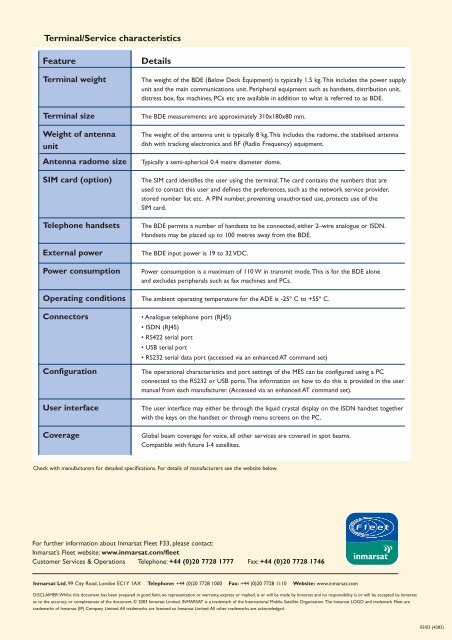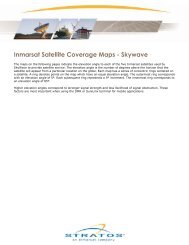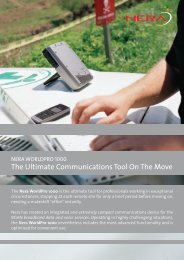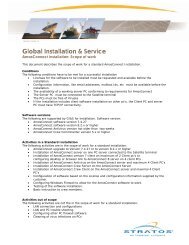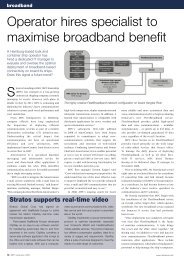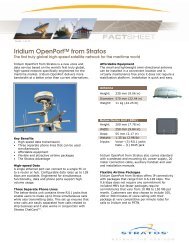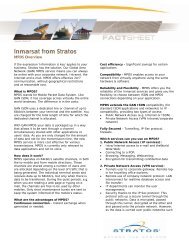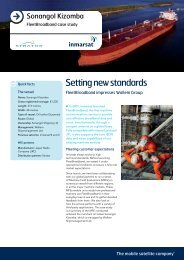Fleet F33 - Technical Specifications - Stratos Global Corporation
Fleet F33 - Technical Specifications - Stratos Global Corporation
Fleet F33 - Technical Specifications - Stratos Global Corporation
Create successful ePaper yourself
Turn your PDF publications into a flip-book with our unique Google optimized e-Paper software.
Terminal/Service characteristics<br />
Feature<br />
Terminal weight<br />
Terminal size<br />
Weight of antenna<br />
unit<br />
Antenna radome size<br />
SIM card (option)<br />
Telephone handsets<br />
External power<br />
Power consumption<br />
Operating conditions<br />
Connectors<br />
Configuration<br />
User interface<br />
Coverage<br />
Details<br />
The weight of the BDE (Below Deck Equipment) is typically 1.5 kg.This includes the power supply<br />
unit and the main communications unit. Peripheral equipment such as handsets, distribution unit,<br />
distress box, fax machines, PCs etc are available in addition to what is referred to as BDE.<br />
The BDE measurements are approximately 310x180x80 mm.<br />
The weight of the antenna unit is typically 8 kg.This includes the radome, the stabilised antenna<br />
dish with tracking electronics and RF (Radio Frequency) equipment.<br />
Typically a semi-spherical 0.4 metre diameter dome.<br />
The SIM card identifies the user using the terminal.The card contains the numbers that are<br />
used to contact this user and defines the preferences, such as the network service provider,<br />
stored number list etc. A PIN number, preventing unauthorised use, protects use of the<br />
SIM card.<br />
The BDE permits a number of handsets to be connected, either 2–wire analogue or ISDN.<br />
Handsets may be placed up to 100 metres away from the BDE.<br />
The BDE input power is 19 to 32 VDC.<br />
Power consumption is a maximum of 110 W in transmit mode.This is for the BDE alone<br />
and excludes peripherals such as fax machines and PCs.<br />
The ambient operating temperature for the ADE is -25º C to +55º C.<br />
• Analogue telephone port (RJ45)<br />
• ISDN (RJ45)<br />
• RS422 serial port<br />
• USB serial port<br />
• RS232 serial data port (accessed via an enhanced AT command set)<br />
The operational characteristics and port settings of the MES can be configured using a PC<br />
connected to the RS232 or USB ports.The information on how to do this is provided in the user<br />
manual from each manufacturer. (Accessed via an enhanced AT command set).<br />
The user interface may either be through the liquid crystal display on the ISDN handset together<br />
with the keys on the handset or through menu screens on the PC.<br />
<strong>Global</strong> beam coverage for voice, all other services are covered in spot beams.<br />
Compatible with future I-4 satellites.<br />
Check with manufacturers for detailed specifications. For details of manufacturers see the website below.<br />
For further information about Inmarsat <strong>Fleet</strong> <strong>F33</strong>, please contact:<br />
Inmarsat’s <strong>Fleet</strong> website: www.inmarsat.com/fleet<br />
Customer Services & Operations Telephone: +44 (0)20 7728 1777 Fax: +44 (0)20 7728 1746<br />
Inmarsat Ltd, 99 City Road, London EC1Y 1AX Telephone: +44 (0)20 7728 1000 Fax: +44 (0)20 7728 1110 Website: www.inmarsat.com<br />
DISCLAIMER:Whilst this document has been prepared in good faith, no representation or warranty, express or implied, is or will be made by Inmarsat and no responsibility is or will be accepted by Inmarsat<br />
as to the accuracy or completeness of the document. © 2003 Inmarsat Limited. INMARSAT is a trademark of the International Mobile Satellite Organisation.The Inmarsat LOGO and trademark <strong>Fleet</strong> are<br />
trademarks of Inmarsat (IP) Company Limited.All trademarks are licensed to Inmarsat Limited.All other trademarks are acknowledged.<br />
03/03 (4283)


